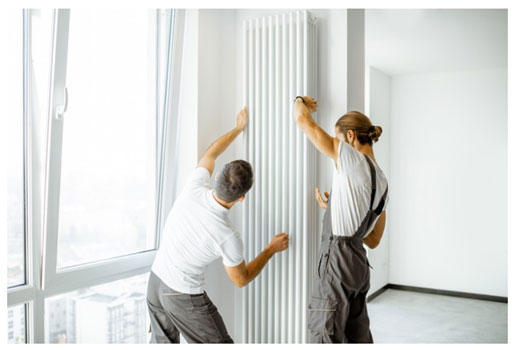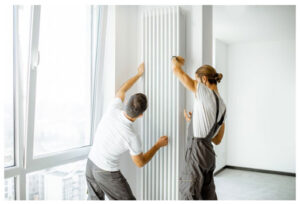Guide to Fitting New Radiator to Existing Pipes Successfully

Are you looking to enhance the comfort of your home with a new radiator installation?
Whether you’re replacing an old radiator or adding a new one to your existing heating system, it’s important to know the necessary steps for a successful installation process. In this guide, we’ll provide comprehensive instructions on how to fit a new radiator to existing pipes.
First things first, ensure that you have all the necessary tools and materials for the installation process. This includes a new radiator, valves, fittings, a pipe cutter, a pipe wrench, pipe sealing tape, and a bucket for draining the system.
Once you have all the required materials, it’s time to begin the installation process. Follow these steps for a smooth installation:
Key Takeaways:
- Fitting a new radiator to existing pipes can enhance the comfort and efficiency of your home’s heating system.
- Ensure you have all the necessary tools and materials for the installation process.
- Follow a step-by-step guide to ensure a smooth installation process.
- Consider professional installation services for expert assistance.
- Testing and troubleshooting the new radiator is important after installation.
Choosing the Right Radiator for Your Space
Before you begin the installation process, it’s important to choose the right radiator for your space. There are several factors to consider, such as heat output, size, and style. It’s always recommended to seek professional advice, especially if you are uncertain about the most suitable type of radiator for your needs.
If you’re looking for a hassle-free experience, a radiator installation company can provide professional radiator fitting services. They will assess your space, recommend the most appropriate type of radiator and ensure a seamless installation process. Not only will this save you time and effort, but it will also give you peace of mind.
When choosing a radiator, consider the heat output required to effectively warm your space. The amount of heat needed is dependent on several factors, including the size of the room and any insulation. Additionally, the style of the radiator can have a significant impact on the overall look and feel of your space.
Professional radiator installation companies have a wide range of options available, including traditional and contemporary styles. They can advise on the most appropriate style for your space, while also ensuring that it matches your existing decor.
Preparing Your Existing Pipes for the New Radiator
Before installing your new radiator, it’s important to properly prepare your existing pipes. This will ensure that the installation goes smoothly and that your new radiator functions at its best.
The first step in preparing your pipes is to drain the heating system. This involves turning off your boiler and allowing the radiators to cool down. Once they’re cool, you can attach a hose to the drain valve and let the water drain out into a container or outside. Be sure to open all the radiator valves to allow the water to flow freely.
Once the system is drained, you can remove your old radiator (if applicable) and begin inspecting the pipes. Check for any signs of damage, such as leaks or corrosion. If you notice any issues, it’s important to address them before installing your new radiator.
Next, you’ll need to clean the pipes. This can be done using a pipe cleaning solution or a wire brush. Be sure to remove any debris or rust that may have accumulated inside the pipes. This will help ensure that your new radiator operates efficiently and that there are no blockages in the system.
If you’re installing a new radiator in an existing heating system, it’s important to ensure that the new radiator is compatible with the system. Consider factors such as size and heat output, and consult with a professional if needed.
Finally, double-check that all valves and fittings are tightly secured and in good condition. This will help prevent any leaks or other issues once the system is turned back on.
By properly preparing your existing pipes, you can ensure a smooth and successful installation of your new radiator into your existing heating system.
Installing the New Radiator
Once you’ve chosen the right radiator for your space and prepared your existing pipes, it’s time to install the new radiator. Follow these steps for a successful installation:
- Place the radiator in the desired location and use a spirit level to ensure it is level.
- Attach the brackets to the wall, making sure they are level and secure.
- If you’re replacing an old radiator, use a spanner to remove the valves from the old radiator and make sure the pipes are clean and in good condition.
- If you’re installing a new radiator, use a pipe cutter to cut the existing pipes to the correct length and use a deburring tool to remove any burrs.
- Connect the radiator to the existing pipes using valves and fittings. Use PTFE tape on the threads of any joints to ensure a watertight seal.
- Open any valves to allow the water to flow into the radiator.
- Bleed the radiator to remove any trapped air, starting with the lowest radiator in the system and working your way up. Use a radiator key to open the valve and allow the air to escape until water starts to come out.
- Test the system for leaks and ensure the radiator is functioning properly.
If you encounter any issues during the installation process, such as leaks or difficulty connecting the valves and fittings, consider calling a professional radiator installation company to assist you.
With these steps, you can successfully fit a new radiator to existing pipes or replace a radiator in an existing setup.
Testing and Troubleshooting
After the new radiator is installed, it’s important to test it to ensure it’s functioning properly. Turn on the heating system and check if the radiator heats up evenly. If some parts of the radiator remain cold, it may indicate an issue with the valve or pipe. Check the valve and make sure it’s fully open. If that doesn’t help, there might be air trapped in the system. In this case, you can open the bleed valve to release the air and repeat the process until the radiator heats up evenly and no more air escapes.
If the radiator doesn’t heat up at all, there may be a problem with the installation. Check the connections between the radiator and the existing pipes and make sure they’re secure. If you notice any leaks, tighten the connections or replace the faulty parts. It’s important to address leaks as soon as possible to prevent water damage to your home.
If you’ve followed our guide and are still experiencing issues, it may be time to seek the help of a professional. A radiator replacement or fitting a new radiator can be a complex process, and an expert can diagnose and repair any problems quickly and efficiently. Don’t hesitate to contact a professional radiator installation company for assistance.
Conclusion
Installing a new radiator to existing pipes is a great way to enhance the comfort of your home, and it’s a relatively straightforward process. By following the steps outlined in this guide, you can successfully replace an old radiator or add a new one to your heating system.
Remember, it’s important to choose the right radiator for your space, considering factors like heat output, size, and style. If you’re unsure about which radiator to choose, consider consulting with a professional radiator installation company.
Preparing your existing pipes for the new radiator is also crucial to ensuring a smooth installation process. Drain the system, remove the old radiator if necessary, and ensure the pipes are clean and in good condition. Don’t forget to make any necessary repairs or upgrades before proceeding with the installation.
Installing the new radiator involves connecting it to the existing pipes using valves and fittings. Bleed the system and test for leaks once you’ve finished the installation to ensure the radiator is functioning properly.
If you encounter any issues during the installation process, don’t hesitate to troubleshoot and seek expert assistance if necessary. With the right approach, you can successfully fit a new radiator to existing pipes and enjoy a more comfortable and efficient home heating system.
FAQ
Q: Can I fit a new radiator to existing pipes?
A: Yes, it is possible to fit a new radiator to existing pipes. This guide will provide you with the necessary steps and tips for a successful installation.
Q: How do I choose the right radiator for my space?
A: When choosing a radiator, consider factors such as heat output, size, and style. We’ll provide helpful information to assist you in making the right choice for your needs.
Q: How do I prepare my existing pipes for the new radiator?
A: To prepare your existing pipes, you’ll need to drain the system, remove the old radiator (if applicable), and ensure the pipes are clean and in good condition. We’ll provide guidance on these steps.
Q: What is the process for installing the new radiator?
A: The installation process involves connecting the new radiator to the existing pipes using valves and fittings. We’ll walk you through the step-by-step instructions, including bleeding the system and testing for leaks.
Q: How do I test and troubleshoot the new radiator?
A: After installation, it’s important to test the radiator and address any potential issues. We’ll provide guidance on how to ensure proper functioning and troubleshoot common problems that may arise.
Q: Can I seek professional assistance for radiator installation?
A: If you’re not confident in your ability to install a radiator yourself, there are professional installation services available. We’ll discuss the benefits of seeking expert assistance.
Take Action Now!
Explore our best-selling radiators in the UK and choose one that fits your budget and requirements. Don’t settle for a subpar heating system and upgrade your home heating with the best selling radiators today. Your comfort, energy bills, and the environment will thank you.
It is crucial to seek guidance from the manufacturer and a certified professional for the installation process to ensure safety and compliance with all technical specifications and requirements. Proper installation is key to the optimal performance and longevity of the product.
Additionally, professional installation may be necessary to maintain the product’s warranty. Therefore, it is highly recommended to consult with experts and not attempt to install the product yourself unless you are qualified to do so.




